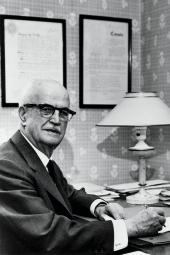
Born at St. Stephen, New Brunswick on July 10, 1888, Mackenzie was educated as a civil engineer at Dalhousie and Harvard. After service in World War I, he came to the University of Saskatchewan as Dean of Engineering in 1921, and continued in this post until 1939. His research concentrated on the protection of concrete from erosion by the alkaline soils of southern Saskatchewan. This was a significant contribution to the building of the province because it had been discovered that the concrete then used was subject to rapid deterioration in the prairie soils. His research led to his being commissioned to design and build, with his students, major central bridges in Saskatoon. He joined the National Research Council in 1935, becoming acting president in 1939 thorough 1944, then president from 1944 to 1952. At the same time he served on the Atomic Energy Control Board, of which he was president from 1948 to 1961.
Mackenzie was a senior scientific administrator and government advisor at the national level at a time - the end of World War II, the beginning of the atomic age, and the Sputnik era - when science policy and research activities became increasingly important for the country. His promotion of university and industrial research in a wide range of fields changed the face of Canadian research and the nature of the Canadian universities. His efforts were recognized by many awards, including membership in the Royal Society of London, the Royal Society of Canada, and the Order of Canada. He died in Ottawa on February 26, 1984.
Diane Secoy